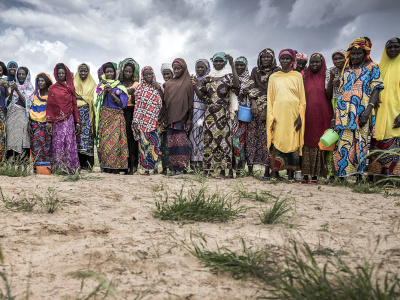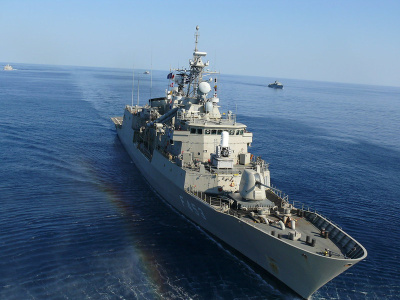
Climate change, conflict and crisis in Lake Chad
Lake Chad is caught in a conflict trap. Climate change and conflict dynamics create a feedback loop. The impacts of climate change seed additional pressure for conflict, while conflict undermines communities’ capacity to cope with climate risks. If the region is to break free from the conflict trap, climate risks have to be tackled as part of peacebuilding efforts. Lake Chad can once again become an engine for sustainable livelihoods and stability.
Caught in a conflict trap
Lake Chad is an ecological miracle: a freshwater lake in the middle of the arid Sahara desert. Yet, since 2009, the region has been destabilised by alarming violence between armed opposition groups (such as Boko Haram and Islamic State West Africa) and state security forces. The ensuing humanitarian crisis has displaced over 2.5 million people from their homes, leaving vast areas insecure and tens of millions people without adequate services. Currently, an estimated 10.7 million are in need of immediate humanitarian assistance.
While the current crisis was triggered by violence linked to armed groups, the situation has deep roots in longstanding developmental challenges. There is widespread inequality and decades of political marginalisation. This has instilled an entrenched sense of exclusion and lack of trust between communities and the government. Against this backdrop, the region also faces significant environmental stresses.
The changing climate has played a very real role in exacerbating and prolonging the existing crisis. But the tendency to draw a direct line of causation between the alleged shrinking of Lake Chad and conflict and the intractability of the humanitarian emergency misses the real role of climate change.
Current research demonstrates that global warming is not shrinking Lake Chad, which actually grows and contracts intra- and inter-annually (Nagarajan et al. 2018). Instead, more changeable and unpredictable rainfall patterns, induced by climate change, have had the most impact on the resilience of communities around the lake. The resulting resource scarcity, livelihood insecurity and extreme poverty have exacerbated existing social tensions.
Adelphi, with support from the Dutch and the German governments, has just completed a climate-fragility risk assessment of the Lake Chad region to better understand the risks from the ground up. With a team of local conflict researchers and climate change experts from the Institut de Recherche pour le Développement (IRD), the assessment brings together nuanced qualitative data on conflict from over 250 community-level interviews, with brand new satellite observations of the lake, to better understand the risks and inform linked solutions to the region’s complex problems.
Four key climate fragility risks
The assessment points to four key climate fragility risks affecting the stability of the region:
1. Climate change and ecological changes increase livelihood insecurity and social tensions: Increased climate variability – especially less predictable rainfall patterns – is undermining livelihoods, livelihood diversity and resilience, leading to adverse livelihood strategies such as deforestation and sex for food. These causal links are strong and easy to trace. The pressures they exert undermine social cohesion and increase tension and conflicts at all levels, from within families to between different ethno-linguistic groups.
2. Conflict and fragility increase vulnerability to climate risks: The ongoing conflict has significantly undermined community resilience, including populations’ ability to adapt to climate change. For example, blocked access to parts of Lake Chad by Boko Haram or state security forces has deprived communities of important livelihood diversification options, such as fishing and farming on the fertile shore lands. This has reduced their coping capacity, which impedes future efforts to address conflict and climate risks.
3. Climate change exacerbates conflicts over natural resources: Before the rise of Boko Haram, there was already a trend of increasing conflicts around natural resources, particularly over land and water, and often between different occupational groups, such as pastoralists and farmers. These conflicts diminished with the emergence of conflict with armed opposition groups, but they have seen recent resurgence. After the Boko Haram crisis is stabilised, it is likely that they will regain salience. It is as yet uncertain how they will play out in the new context of reduced resilience.
4. Livelihood insecurity plays into recruitment to armed groups: Recruitment into non-state armed opposition groups is increasing, with retention rates sustained by social and economic inequalities. People with increasingly vulnerable livelihoods are particularly susceptible to the financial incentives offered by armed groups for joining. There is also an emerging wave of persons choosing to return to Boko Haram from the camps for internally displaced persons (IDPs). These trends are directly linked to climate change. Climate change and conflict have made jobs less viable, while the lack of livelihood options and equitable service provision in the IDP camps has fuelled disruption. To be clear, climate change does not create terrorists, nor does it turn law-abiding citizens into criminals. But a warming world acts as a “threat multiplier”, worsening existing risks and making it harder to work on solutions. The linked implications of climatic variability, human-induced ecological damage and conflict on different livelihood strategies are still unclear and need to be better understood.
Taken together, these risks create a self-reinforcing feedback loop between increasing livelihood insecurity, climate change vulnerability, and conflict and fragility. Conflict and fragility undermine the resilience of communities, making them more vulnerable to climate change, while climate change at the same time is undermining livelihoods and exacerbating competition around scarcer natural resources. If not broken, this vicious loop threatens to perpetuate the current crisis and take the region further down the path of conflict and fragility.
What should be done?
To tackle this crisis with any kind of sustainability we need a thorough understanding of what caused it to spiral in the first place. Despite the significant role climate change plays in shaping the risk landscape, there is as yet no peacebuilding, stabilisation, humanitarian or development process that explicitly considers the role of climate change in either risks or shaping appropriate responses.
The most effective solutions will be ones that address the underlying causes of the crisis and are sensitive to the environmental changes brought about by climate change. Stabilisation, humanitarian and development efforts in the region must better understand the interactions between environmental and climatic factors and the security and humanitarian context. This requires greater cognisance of the linked conflict, humanitarian, environmental and developmental risks in the region and steps towards ensuring that interventions do not worsen climate fragility. For example, reintegration and resettlement programmes should include a clear focus on livelihood planning that acknowledges the variability of climatic conditions in the region.
A climate fragility risk assessment is a good first step to understand the joint risks and inform joint solutions to the complex problems faced in the Lake Chad region. This will be the best first step in any context facing both climate change and conflict risks. But an assessment is only as good as the institutional will and capacity to take up and respond to its findings. This points to the need to generate understanding and buy-in to address these compound risks across institutions that have historically worked in separate silos.
The Berlin Climate and Security Conference on 4 June 2019 was a milestone towards generating greater awareness and buy-in for more coherent approaches. The UN Secretary-General’s Climate Action Summit in September 2019 was another important marker in institutionalising such an approach within the UN system. The proof will be in joined-up programming on the ground.
Further reading
Vivekananda, J., et al. (2019) Shoring up Stability. Berlin: Adelphi
Nagarajan, C., B. Pohl, L. Rüttinger, F. Sylvestre, J. Vivekananda, M. Wall and S. Wolfmaier (2018) Climate-Fragility Profile: Lake Chad Basin. Berlin: Adelphi.
About the author
Janani Vivekananda is Senior Advisor at Adelphi, where she specialises in climate change and peacebuilding.
Read the full magazine issue









